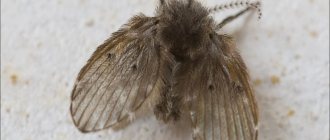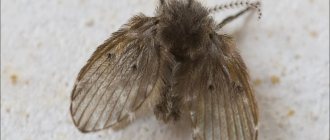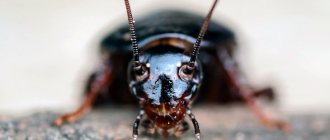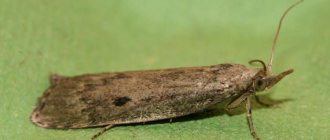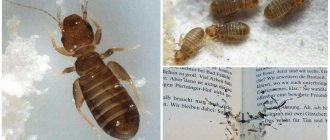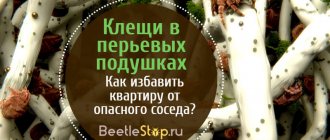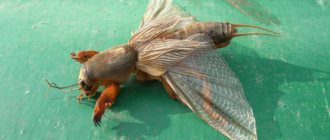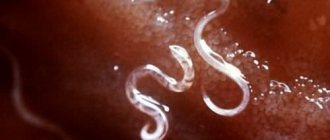Just yesterday the seedlings were pleased with their good health and lush appearance, but today the seedlings suddenly began to fold their “heads” en masse? One of the possible causes of trouble is whitefly leprosy. If this is your case, don't despair! We will tell you how to quickly defeat the enemy.
The whitefly harms vegetable and flower crops in summer cottages (usually in a greenhouse), but can easily settle in our homes. The threat of pest spread comes from poor-quality soil in which the seedlings grow, or from a houseplant recently arrived from a flower shop.
This voracious and prolific prankster can quickly destroy all the seedlings and dispel the dream of a rich harvest. Therefore, when you notice the first signs of whitefly on seedlings, immediately go on the warpath.
Description
Small white insects that parasitize plants in the garden are familiar to every gardener. This is a whitefly. Likes to live on indoor plants and in greenhouses. This is facilitated by high humidity and frequent watering. It is rarely found in open ground, but outbreaks occur when plant growing conditions are violated. Most often found on vegetable crops: tomatoes, cabbage, strawberries, peppers. A seemingly harmless insect can turn into a real disaster for plants and their owners.
Gardeners do not immediately recognize the threat, since whiteflies are very similar to aphids. They feed on the sap of the plant, which weakens and reduces the plant’s immunity. And this, in turn, leads to the death of the seedling. Preventive measures can help, as well as timely identification of the pest.
Life cycle
All stages of the pest can go through the winter, but most often it is experienced by adult insects and larvae at the stage of puparia - false cocoon. The life cycle of whiteflies has 6 stages of development:
- Egg. The first years of insects can be observed in late May - early June. They lay eggs on the underside of leaves. The masonry looks like a ring or half ring. The eggs are small, no more than 0.2 mm in length, at first they are light yellow, darkening over time. They have a stalk at the upper end. With its help, the eggs are attached to the plant. The duration of the stage is 3 – 9 days.
- Larva of the first instar. The stage lasts from 2 to 6 hours. The larva is mobile, light-colored, covered with a waxy coating on top. She moves around, looking for a place to feed, which is why she is called a tramp or a creeper.
- Larva of the second instar. The stage lasts up to 4–5 days, the limbs and antennae are shortened, and mobility is lost.
- Larva of the third instar. At this stage, the antennae and limbs practically atrophy. The larva is motionless.
- Larvae of the fourth instar. After 4–5 days, the larva becomes like an oval-shaped wax capsule surrounded by a ring of wax spikes. This stage is called the false pupa or puparia. They are light, up to 1.2 mm long, up to 0.7 mm wide. In autumn they change color to dark. The stage lasts up to 9 days. At this time, the legs, wings, antennae and other organs of an adult insect are formed inside the wax cocoon, and the body acquires volume. Just before exiting the puparia, feeding stops.
- Imago. 10 – 12 hours after leaving the cocoon it is ready to mate. After 2–3 days, the female begins to lay eggs and the cycle repeats. Its average duration ranges from 20 to 40 days.
Fertility
In temperate climates, whiteflies produce from 1 to 3 generations. In the south or in a greenhouse they reproduce year-round. The number of eggs produced by one adult female depends on the ambient temperature.
The most favorable temperature is + 20 degrees Celsius. Under these conditions, the number of eggs laid by one female is 210–230. If the air does not warm up above 15 - 16 degrees, then one female lays from 30 to 150 eggs. The lifespan of adults varies from several days to one and a half to two months. Females are more durable than males.
Which plants does it parasitize?
The greenhouse whitefly harms many indoor vegetable crops: tomatoes, cucumbers, peppers, and is also found on greens and flowers. And if it is not possible to take a break from growing and freezing the room in winter, it is very difficult to fight insects.
Cabbage whitefly primarily harms cabbage and vegetables from the Cruciferous family. Found on other vegetables and herbaceous plants. Closely related species parasitize berry and fruit plantations, nightshade crops and cotton.
Dangerous for flowers and ornamental plants. Settles on medicinal herbs. In total, up to 30 species of whiteflies are found in the Russian Federation and CIS countries.
What is the danger of a pest for plants and crop loss?
Whiteflies are dangerous for the plant primarily because they disrupt the nutrition of the green parts, sucking out their juice. Single specimens do not cause much harm, but an overgrown colony of whiteflies negatively affects the process of photosynthesis and respiration. Normal vegetation is disrupted, damage and drying out of leaf plates and other above-ground parts of the plant occurs.
The pest feeds at all stages except the egg and before the end of the puparium stage. Whiteflies are carriers of 60 species of plant viral pathogens.
With a slight spread of whiteflies, no more than 15–20% of host plants die. In advanced cases, you can lose 50–60% of the harvest of vegetables, berries and other crops.
Fungal diseases develop on plants from droppings and honeydew (sugary) secretions of insects. From which the loss of crops in protected soil can be up to 100%.
Signs of whitefly in the garden
An inexperienced gardener may confuse whiteflies with aphids, but if you look closely, you can see a significant difference. The whitefly is slightly larger in size and has distinct wings. If you shake the plant, a cloud of tiny midges will rise up.
The female hides the clutch of eggs under a leaf and looks like a cluster of white dots. The peculiarity of the whitefly is that it is prone to rapid reproduction. If this process is not stopped in time, the entire area will soon wither under its onslaught. During its life, the insect secretes a sweet consistency that covers the leaf, resulting in the formation of dark spots. Thanks to its wings, the pest quickly spreads to neighboring plants. In apartment conditions, even removing plants to the next room cannot be done, because the whitefly flies in search of new food.
The larvae develop in stages. At the end of development they turn into puparia. Puparia are light yellow cocoons from which adults subsequently hatch.
Whitefly in the photo
In the photo there is a cluster of midges on the back side of the leaf
Prevention
- Constant inspection of the leaves will help to detect the insect in time. New plants in the house are quarantined.
- Since whitefly is most often found in protected soil, thorough cleaning and disinfection of greenhouses and greenhouses after harvesting is important. Plant residues and weeds are collected and destroyed, or sent to a compost heap. The soil is dug up, its surface is not leveled until spring.
- Greenhouses are washed and disinfected, paying attention to cracks and joints. After the weather gets colder, it is better to leave the windows and doors of the structure open so that the pests that have settled in for the winter will die. At temperatures from -12°C and below, it is enough to freeze the greenhouse for a week.
- In the summer, nets are installed on doors and windows to prevent insects from entering the room.
Despite the fact that whiteflies multiply quickly, they can and should be fought against. Only systematic measures will get rid of it. Once you start fighting it, you can’t stop!
You will learn more about methods of combating whiteflies from the video.
Reasons for appearance
The most favorable conditions for insect reproduction are high humidity and warm air. Therefore, the greenhouse premises, where it is always humid and warm, are always at risk. Outbreaks occur during hot summers with frequent rainfall. Small midges are not able to withstand extreme cold. Temperatures below 10 C are already destructive for them. But the eggs are adapted by nature to preserve the species and calmly tolerate cold in the ground.
The following factors guarantee the appearance of whiteflies in a greenhouse:
- Close planting;
- Violation of ventilation and temperature conditions;
- Lack of preventive measures to combat pests;
- Lack of regular application of fertilizers that strengthen plant immunity;
- Spraying plants in a greenhouse.
Preventive actions
To prevent harmful insects from appearing on plants again, the following rules must be followed:
- ventilate and change the temperature in the room;
- wipe the leaves of the bushes once a week;
- loosen the top layer of soil;
- do not allow moisture to stagnate in flower pots;
- do not plant bushes too close to each other;
- in the fall, dig up the ground and use soil fumigation;
- the greenhouse can be frozen in winter;
- treat the soil with ash and other disinfectants;
- Cover infected plants with film to prevent midges from spreading further.
Fighting methods
They fight this annoying and dangerous pest in different ways. For some, only folk remedies that do not contain chemicals and are safe for humans are acceptable, while others do not see any other way how to quickly destroy midges using insecticides and chemicals.
A special feature of treatment with poisons is the regular repetition of the procedure until the whitefly is completely destroyed. The fact is that the poison only affects larvae and adults, but not eggs. Therefore, repeated spraying is done in order to destroy the hatched larvae before they are able to reproduce.
It should be remembered that toxic substances accumulate in vegetables and eating them can be dangerous. Therefore, you should adhere to the proportions established by the manufacturer, which are described in the instructions attached to the insecticides.
Chemicals
Choose the safest drugs for treatment and follow the instructions when diluting the solution
"Admiral". It is a low-toxic drug used to kill insect pests. Available in the form of a concentrated emulsion. It is used diluted in a proportion of 0.2 l/ha. The consumption of Admiral working fluid is 1000 l/ha. Processing is carried out 1 time.
"Aktara". Treatment with this substance helps get rid of whiteflies for a period of up to 1 month. The treatment is repeated 3 times after 7 days. Vegetables can be eaten only after 60 days after the last application of Aktara. 1 sachet, containing 4 g, is diluted in 5 liters of water. This is enough for a large greenhouse area. To destroy, spray and water at the root.
"Aplaud." Can be used both in greenhouses and in open ground. Japanese insecticide allows you to get rid of insects for 1 month. Diluted 0.5 kg per 1 ha. To process 1 hectare you will need 1500 liters of water.
"Confidor". The drug is quite effective, so one treatment is enough. After an hour, the midges begin to die.
"Iskra Golden" These are tablets that easily dissolve in water. Also available in the form of ampoules, powder and sticks. A solution of 2 ml per 10 liters of water is prepared and sprayed on the plants. 1 or 2 treatments with Iskra Zolotoy are enough.
"Tanrek". A very effective and low-toxic substance that practically does not accumulate in fruits. To spray vegetables and indoor plants, you need to take 5 ml of the drug per 10 liters of water, for trees and bushes, 3 ml. Safety precautions must be observed when working with Tanrek, so be sure to wear respirators or face masks.
"Fitoverm". Dilute 4-8 ml per 1 liter of water, depending on what you plan to spray and against what pest. The treatment is carried out several times to destroy all adults and those that hatched after the treatment.
"Fufanon." Low-toxic drug, which is diluted at the rate of 10 ml per 10 liters of water. First, the solution is added to a small amount of water, and then poured into the rest. The Fufanon working solution is prepared at 3 liters per 10 sq.m.
Biological methods
Chemical preparations against whiteflies are gradually losing their relevance. Biological methods of control are being replaced. Examples:
- Placing encarsia pupae in greenhouses. The female parasite lays eggs in the bodies of whitefly larvae, which leads to death. Encarsia pupae are launched 2 weeks before planting. Macrolophus bug. Tobacco and greenhouse whiteflies are destroyed. These bugs are released before the active development of the pest. Against whiteflies, 1 insect per 1 m² is enough.
The colonization of greenhouses and greenhouses with entomophages is characterized by an efficiency of up to 99%. Biological enemies are especially useful for pests on tomatoes. Cucumbers contain hairs on the surface, which prevents entomophages.
On a note! Common natural enemies of whiteflies are the lacewing fly, ladybug, and ichneumon beetle.
Mechanical methods for fighting
Trying to protect their crops from whiteflies, gardeners install traps. They look different. Take cardboard or plastic and cover it with non-drying glue. You can prepare the adhesive mixture yourself by taking honey, castor oil, Vaseline and rosin. The smell of honey attracts parasites and they stick to the surface of the trap. Fly tape can also help.
Another effective way is to place fumigators against mosquitoes and flies on the site. The disadvantage of this method is that people and animals cannot be in the greenhouse while the fumigator is operating. Treatment is carried out after 7 days to destroy the larvae that have hatched from the egg.
Nets are also another way to protect plants from insects. Special phytoprotective nets are installed that prevent adults from getting onto the plant. There is no need to use additional chemicals and the vegetables remain environmentally friendly.
A sulfur smoke bomb is designed to “smoke” a room. The checker is used to destroy not only whiteflies, but also other parasitic insects. Smoke not only destroys pests in the garden, but also scares away newcomers. Dichlorvos, which can be sprayed on plants, also works. With the help of dichlorvos, they kill not only whiteflies, but also other pests.
What plants does the pest attack?
This insect attacks more than 300 plant species. Among vegetables, tomatoes suffer most from whitefly. From them he can switch to cucumbers, squash, pumpkins, and eggplants. Cabbage, strawberries, beans, lettuce.
Fruits and berries such as pear, plum, apple, raspberry, currant, gooseberry and honeysuckle are not ignored.
Indoor flowers such as begonias, geraniums, fuchsias, impatiens, myrtles, poinsettias, gerberas, cacti, orchids, cyclamens, viburnums, primroses should be protected from pests all year round. Damages garden flowers: asters, gladioli, tobacco, zinnias.
Different types of whiteflies cannot reproduce on the same plant because their secretions repel each other.
Traditional methods
Gardeners and summer residents in their small plots prefer to cope with the invasion of the parasite using traditional methods. The advantage of these methods is the absolute environmental friendliness of the fruit.
- An effective method is wiping with water. But the method is only suitable for indoor plants and a small number of seedlings. Take a sponge, soak it in water and wipe the leaves with it. The method is painstaking, but you know for sure that you have removed all the larvae.
- The composition of water and laundry soap is prepared in the proportion of 1 part soap to 6 parts water. Water the soil, but not too much, so as not to harm the roots and plant. Repeat in a week.
- Garlic tincture is prepared from 2 large cloves of garlic and 1 liter of hot water. Leave it to sit overnight and then you can spray it on.
- Yarrow tincture is prepared at the rate of 90 g of leaves per 1 liter of water. Let it brew for 2 days and spray the plants. Repeat 3 times every other week.
- Tobacco solution. Experienced gardeners recommend using Prima cigarettes. The tobacco from them is poured into a jar and filled with water. Let it brew for 5 days, strain and spray. Repeat the treatment until the midges completely disappear.
- Dandelion tincture is prepared from 40 g of leaves, 40 g of roots, which are crushed and filled with water. Let it brew for 4 days, strain and process the plants.
- Ammonia is diluted 35 ml per 1 bucket of water. Treatment with ammonia is carried out every 3 days.
- Birch tar is part of tar tincture. Dilute 5 ml per 10 liters of water.
- The vinegar solution is prepared as follows: take 5 tablespoons per 10 liters of water. vinegar essence.
